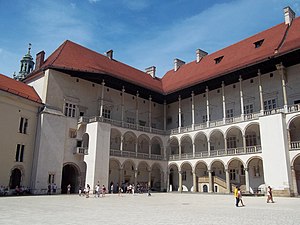Francesco Fiorentino (architect)
Francesco Fiorentino (Polish Franciszek Florentczyk , † October 16, 1516 in Krakow ) was an architect , sculptor and stonemason of the Renaissance . Fiorentino belonged to the first generation of Italian artists who worked at the Kraków royal court.
Life
Francesco Fiorentino was born in Florence before 1450 . He was possibly a student of Bernardo Rossellino , in any case his art style is a further development of the style of Rossellino. In the second half he was active in the Hungarian capital Buda with his own workshop. It was here that the Polish-Lithuanian Crown Prince Sigismund became aware of him before 1498 while visiting his brother Vladislav II the Jagiellonian , King of Hungary and Bohemia. When the Gothic royal castle on the Wawel in Kraków burned down in 1499 , Sigismund persuaded his mother, the queen widow Elisabeth von Habsburg , to have the castle rebuilt by Francesco Fiorentino in the new Renaissance style. Francesco Fiorentino came to Krakow at the end of 1501 or beginning of 1502 with his workshop and numerous helpers, most of whom also came from Florence. In the meantime, Sigismund's and Vladislav's brother, the Polish King John I, had died in the summer of 1501. Elisabeth and Sigismund therefore commission him to erect the tomb for their deceased son and brother in the Jan Olbracht Chapel of the Wawel Cathedral . The grave slab itself came from Stanislaus Stoss , the son of Veit Stoss , and Jörg Huber and is designed in the late Gothic style. The tomb himself was built by Francesco Fiorentino between 1502 and 1505. It is considered the first work of art of the Florentine Renaissance in Poland, which served as a template for numerous similar tombs throughout Poland-Lithuania over the next hundred years . At the same time, he and the bricklayer Eberhard Rosemberger from Koblenz began to rebuild the Wawel Castle on its west wing, the queen's apartment for Elisabeth, which he completed in 1507. At this time Elisabeth had died just like her other son King Alexander , so that Sigismund was now crowned King of Poland-Lithuania. He commissioned Francesco Fiorentino with the further expansion of the royal palace on the north wing, which he began in 1507, but could not complete until his death in 1516. His work was then continued by Bartolomeo Berrecci , also from near Florence. Berrecci also took over the Fiorentino workshop in 1516 with numerous important Italian architects and artists. In 1507 and 1510 he also traveled to Buda again to complete older assignments in Hungary. Fiorentino was a very sought-after and very well paid artist. 1502 alone paid 100 gold flotiners in the Sigismund. He worked almost exclusively for the Jagiellonian royal courts in Buda and Krakow. Alongside Bartolomeo Berrecci, he is considered to be the most important representative of the Florentine High Renaissance in Eastern Central Europe.
Create
From the works of Francesco Fiorentino are preserved:
- Tomb of King John I in the Kraków Johann Chapel of the Wawel Cathedral
- West and north wings of the Royal Castle on the Wawel
- Portal of the Erasmus Ciołek Episcopal Palace in Krakow
literature
- H. i S. Kozakiewiczowie, Renesans w Polsce, wyd. Arkady, Warszawa, 1976
- S. Komornicki, Franciszek Florentczyk i pałac wawelski (Przegląd Historii Sztuki I, Kraków, 1929)
- S. Mossakowski, King Sigismund Chapel at Cracow Cathedral (1515–1533), IRSA, Kraków 2012
- Ostrowski J. Podlecki J., Wawel. zamek i katedra, wyd. Karpaty - Andrzej Łączyński, Kraków, 2004
| personal data | |
|---|---|
| SURNAME | Fiorentino, Francesco |
| ALTERNATIVE NAMES | Florentczyk, Franciszek |
| BRIEF DESCRIPTION | Italian-Polish architect, sculptor and stonemason of the Renaissance |
| DATE OF BIRTH | 15th century |
| DATE OF DEATH | October 16, 1516 |
| Place of death | Krakow |



